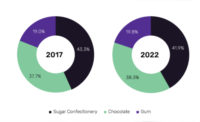Roughly 75 percent of consumers across 19 countries are not influenced by sugar content when purchasing sugar confectionery, according to a survey by Innova Market Insights.
The market research firm reported a quarter of respondents claimed to be influenced by the sugar content of a sugar confectionery product. A similar number of respondents were influenced by whether the product is natural or not.
And while sugar-free gum has been around for many years, sugar-free confectionery as a whole has yet to become such an established sector. According to Innova Market Insights data, just 6 percent of sugar confectionery launches in the 12 months ending in June used a sugar-free positioning, compared with over two-thirds of gum introductions.
That doesn’t mean confectionery manufacturers should cease developing sugar-free or natural products, warned Lu Ann Williams, director of Innova Market Insights.
“Given the growing momentum behind reducing sugar intake, some may argue that sugar confectionery and to a lesser extent gum is on shaky ground,” she said. “However, these products are enjoyed the world over and there are plenty of ways in which companies can head off any future downturn in consumption and sales.”
Across the 10 nations with the highest levels of consumption of both sugar confectionery and gum, consumption is increasing, with compound annual growth rates ranging from 0.5 percent to 3.0 percent over the 2010-2022 forecast period. Innova valued global sales at $85.8 billion in 2017, and they’re expected to reach around $100 billion by 2022.
“While concerns about the unhealthiness of sugar confectionery are apparent when consumers are questioned,” Williams said, “this does not necessarily relate to their actual purchasing or consumption habits.”
The three leading drivers of choice are flavor, cost and indulgence. Indulgence is the key factor that Italian, French and Russian consumers pay importance to when buying sugar confectionery. In other countries, flavor and cost are more important considerations.
The key will be to create interest and excitement in the sugar-free and natural categories, giving consumers a reason to purchase their products over other snack foods.
“The use of flavor will continue to be important to achieve this, but there is also a need to switch to natural flavors following the move to natural colors,” Williams said. “Companies can also look to use more indulgent premium flavors, targeting the adult market with more value added premium-style offerings.”








